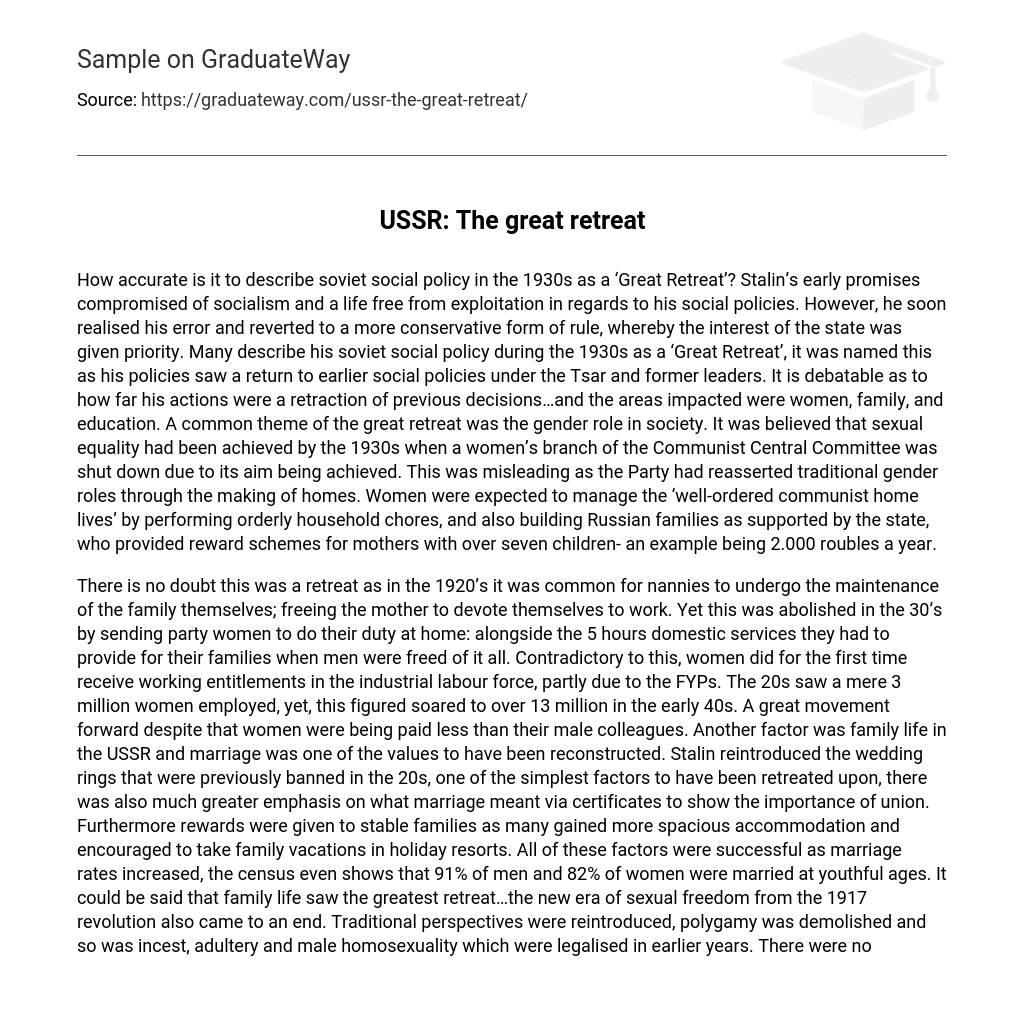How accurate is it to describe soviet social policy in the 1930s as a ‘Great Retreat’? Stalin’s early promises compromised of socialism and a life free from exploitation in regards to his social policies. However, he soon realised his error and reverted to a more conservative form of rule, whereby the interest of the state was given priority. Many describe his soviet social policy during the 1930s as a ‘Great Retreat’, it was named this as his policies saw a return to earlier social policies under the Tsar and former leaders. It is debatable as to how far his actions were a retraction of previous decisions…and the areas impacted were women, family, and education. A common theme of the great retreat was the gender role in society. It was believed that sexual equality had been achieved by the 1930s when a women’s branch of the Communist Central Committee was shut down due to its aim being achieved. This was misleading as the Party had reasserted traditional gender roles through the making of homes. Women were expected to manage the ‘well-ordered communist home lives’ by performing orderly household chores, and also building Russian families as supported by the state, who provided reward schemes for mothers with over seven children- an example being 2.000 roubles a year.
There is no doubt this was a retreat as in the 1920’s it was common for nannies to undergo the maintenance of the family themselves; freeing the mother to devote themselves to work. Yet this was abolished in the 30’s by sending party women to do their duty at home: alongside the 5 hours domestic services they had to provide for their families when men were freed of it all. Contradictory to this, women did for the first time receive working entitlements in the industrial labour force, partly due to the FYPs. The 20s saw a mere 3 million women employed, yet, this figured soared to over 13 million in the early 40s. A great movement forward despite that women were being paid less than their male colleagues. Another factor was family life in the USSR and marriage was one of the values to have been reconstructed. Stalin reintroduced the wedding rings that were previously banned in the 20s, one of the simplest factors to have been retreated upon, there was also much greater emphasis on what marriage meant via certificates to show the importance of union. Furthermore rewards were given to stable families as many gained more spacious accommodation and encouraged to take family vacations in holiday resorts. All of these factors were successful as marriage rates increased, the census even shows that 91% of men and 82% of women were married at youthful ages. It could be said that family life saw the greatest retreat…the new era of sexual freedom from the 1917 revolution also came to an end. Traditional perspectives were reintroduced, polygamy was demolished and so was incest, adultery and male homosexuality which were legalised in earlier years. There were no new implements in family life as it all saw a return to Tsarist values. Thirdly education was a sector affected by the new socialist rules, and it had three key aspects to it; discipline, hard work and tradition.
Education under Stalin saw a huge progress in curriculums and the main aim of study for the youth. The first measure was to reverse the policy of challenging the bourgeois authority of parents as discipline was meant to be enforced as a key factor. The youth were told to respect and love parents despite their views on the communist youth union. In addition to raising good citizens the formal education took a new turn too. Holes were found in the 1920s communist ideals as literacy and numeracy fell short, this was rectified by the 30s plans and history was replaced entirely with teaching content all on Russia’s greatness. In simple terms the scheme of work was devised to prepare the future working generations for the FYPs. Much of the changes to education were dependant on this future work and therefore needed a lot of reconstructing. All communist plans were eradicated, however it was partly a retreat yet partly not; as the new aims were working towards the blueprints of the new economic policies- those who had not been implemented before. In conclusion there is clearly evidence of a ‘Great Retreat’ but it is of how much does this evidence account for in comparison to the whole picture.
The largest retreats saw were in family life and equally in women’s role in society, there is endless proof of Stalin returning to traditional family values as the sexual freedom era was abolished and marriage symbolising legalised again. Yet retreat was also clear in the women’s role as a differentiation in beliefs was key in the gender roles in society- although they were thought to be moving forward stereotypical household women still existed. It is valid enough to call it a great retreat but there are also many movements’ forwards that weren’t evident prior to the social changes, one for example being women in the workforce. Education also saw a retreat by removing communist plans, yet it was also a move forward as it took into account the FYPs and based the educational aims around them. In summary, social qualities in the 1930s in Russia, where dominated by retreats in regard to women and family life. Education could also be part of this with a slight move forward. The few anomalies that did not add to a retreat, for example more working rights for women, do not account for much as they were contradicted by various other laws.





